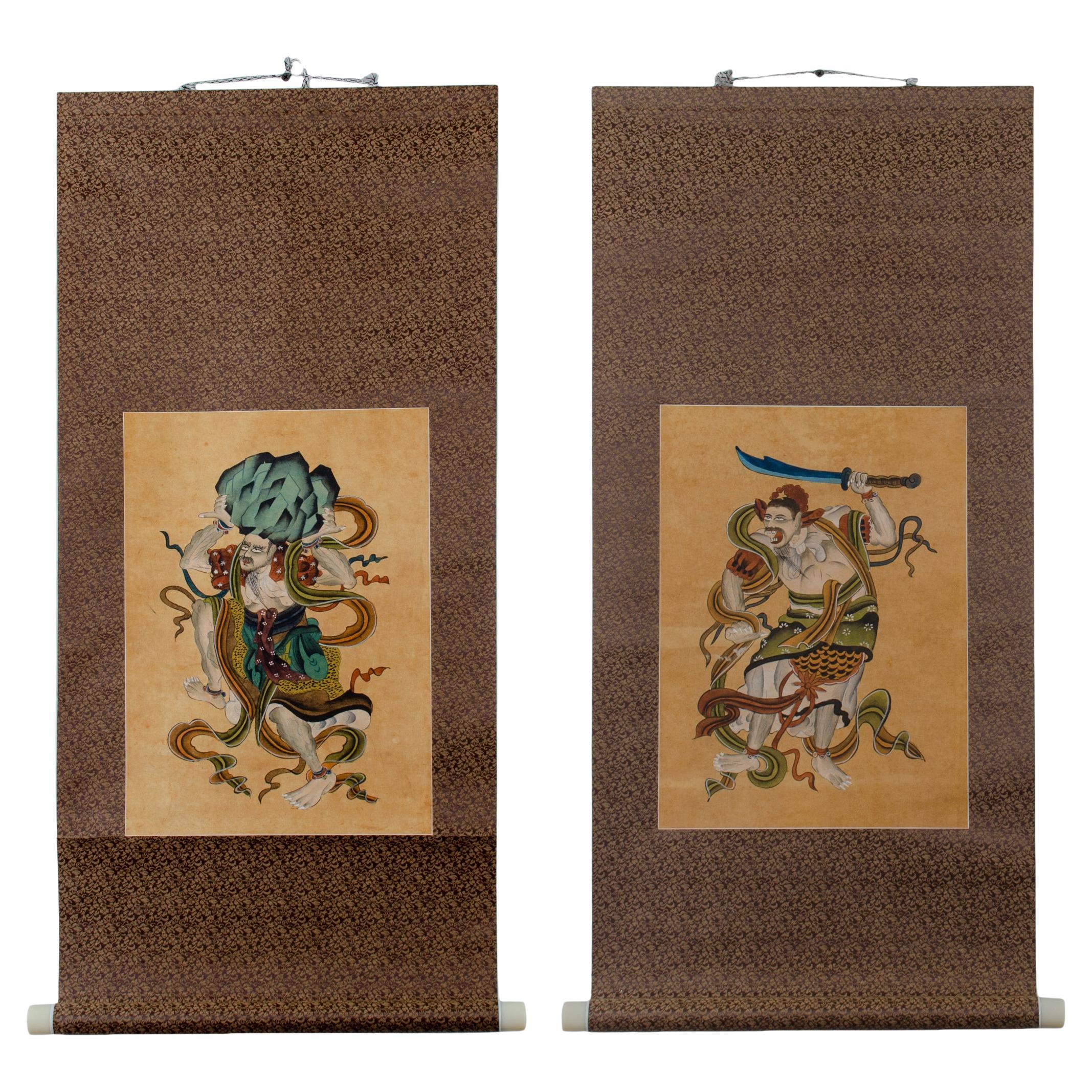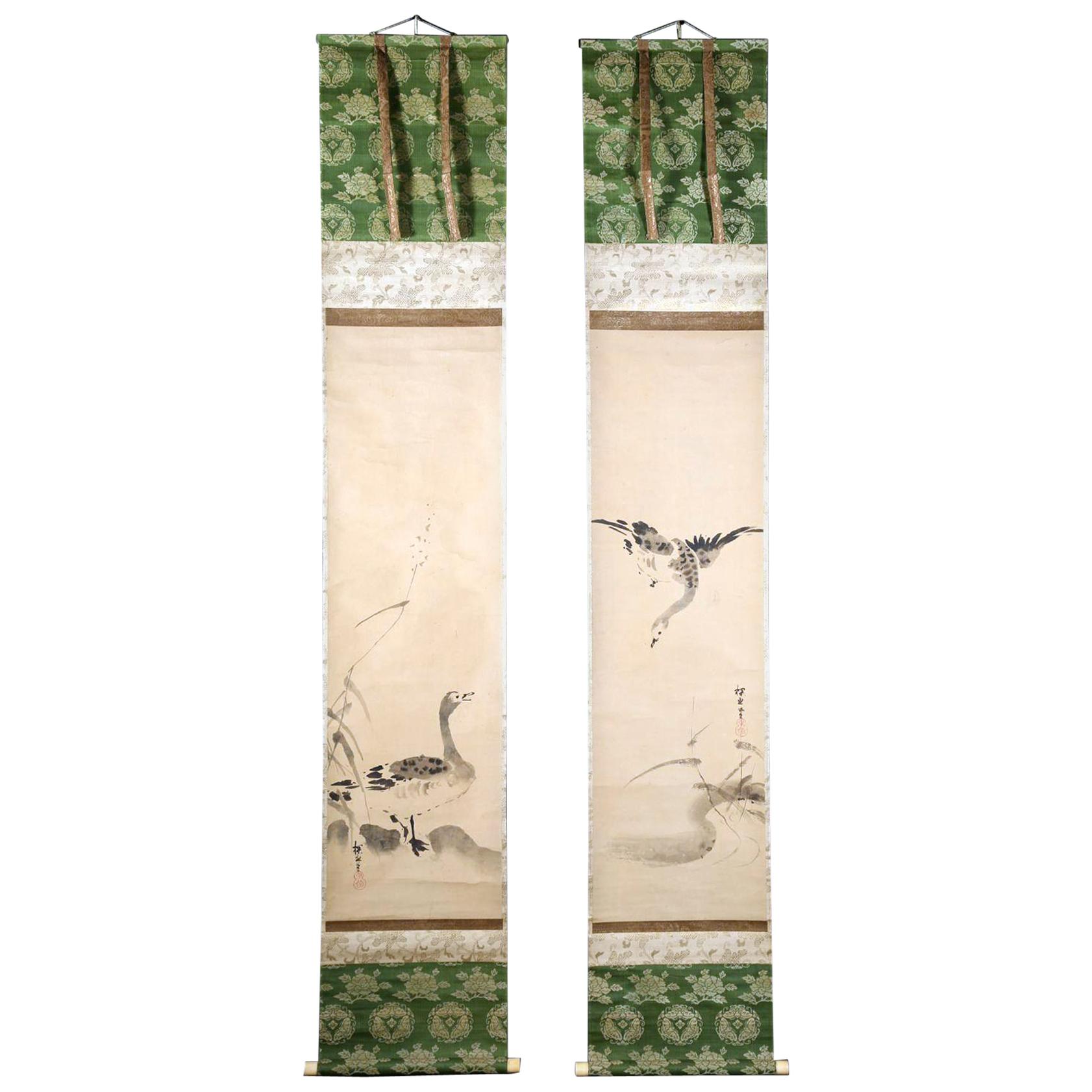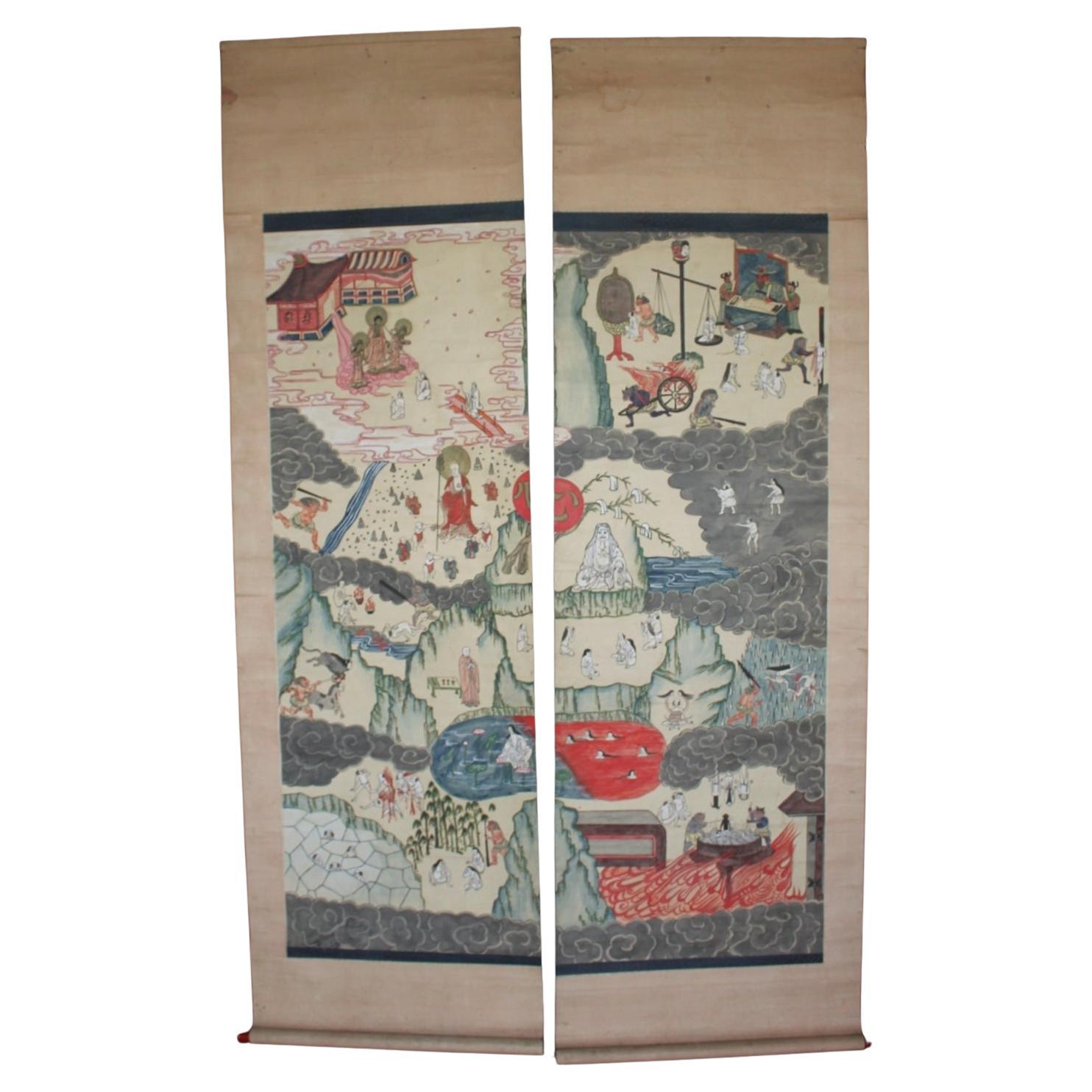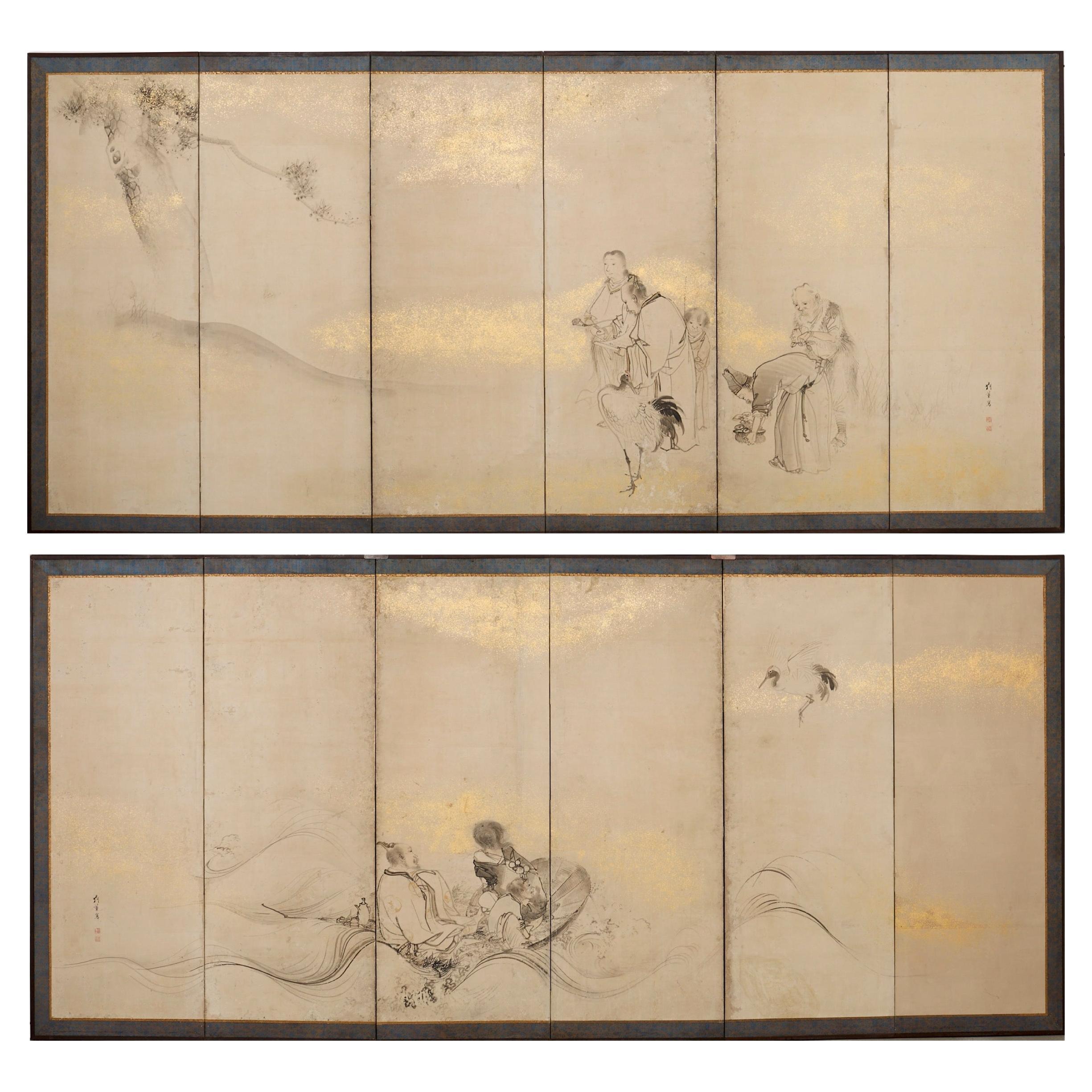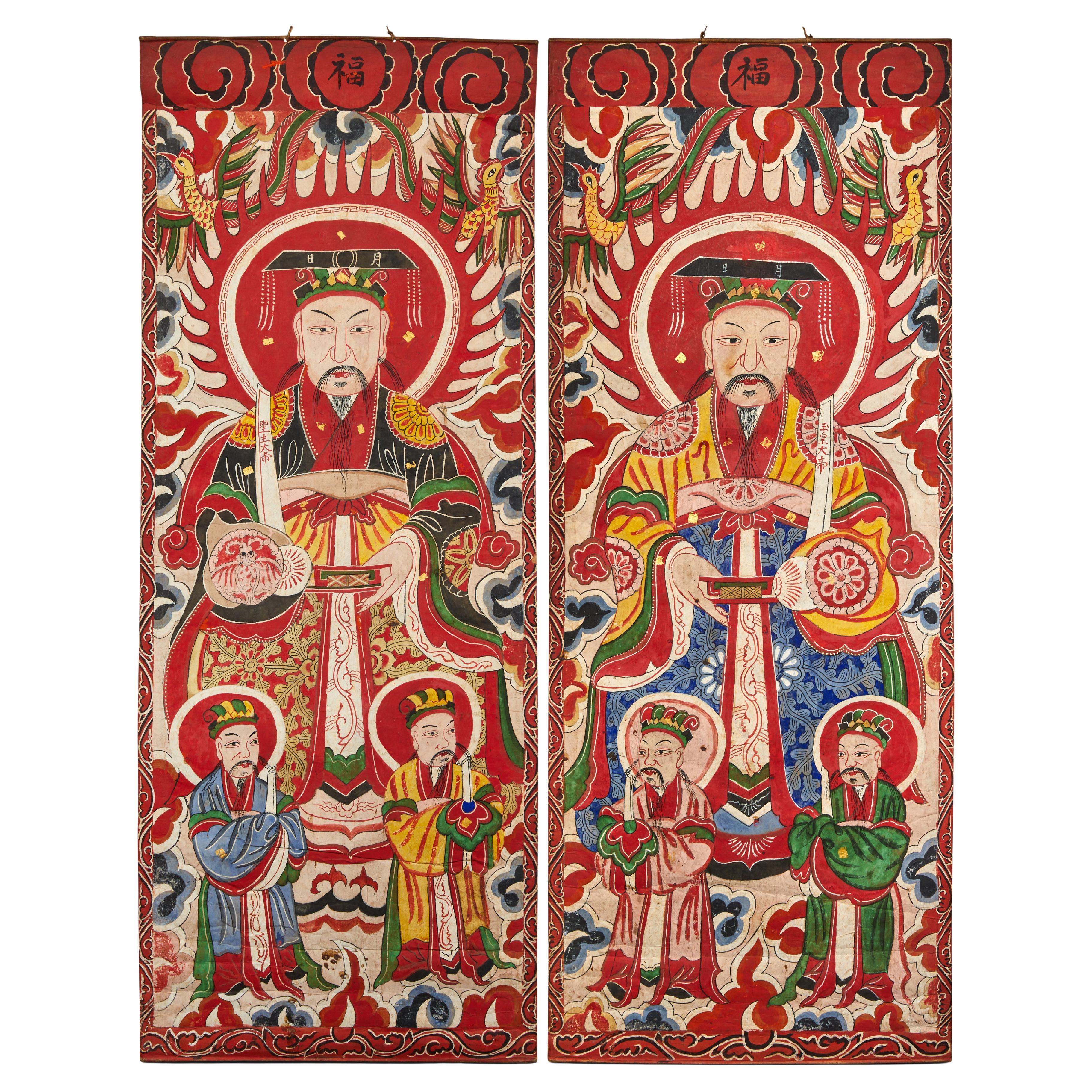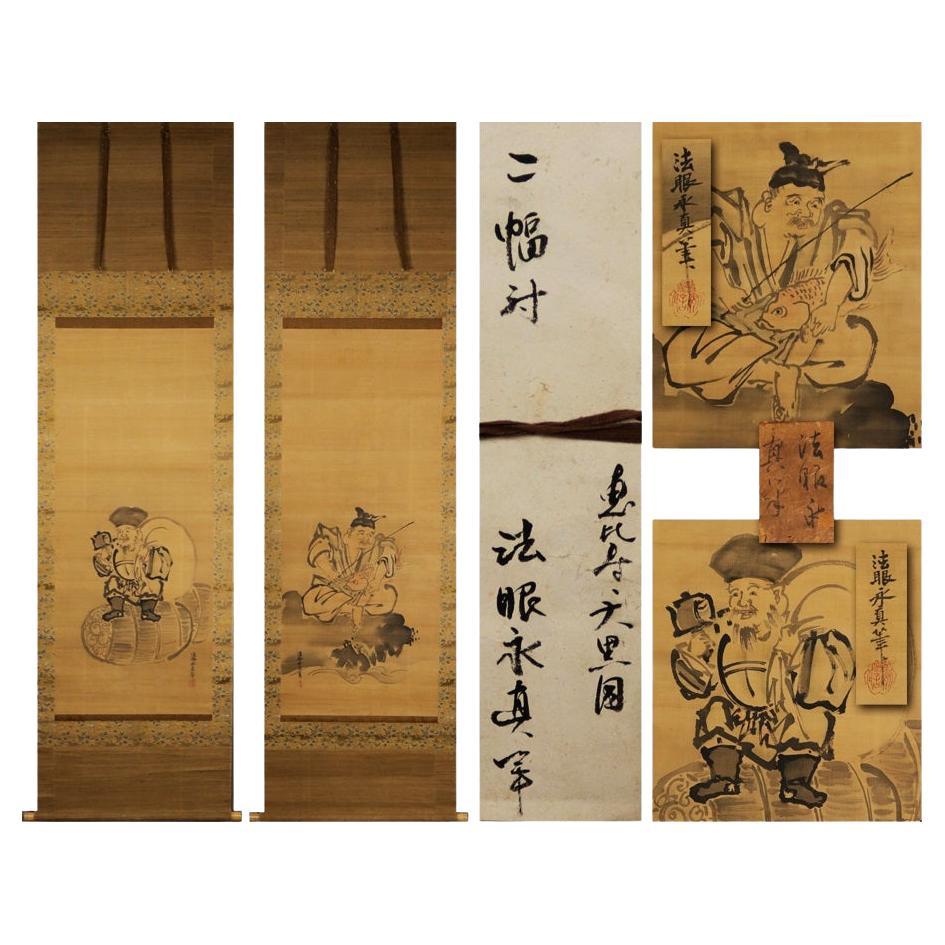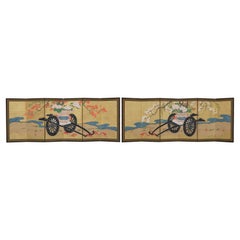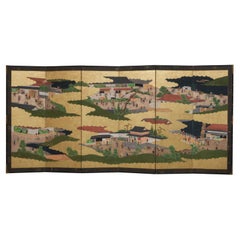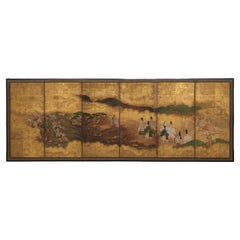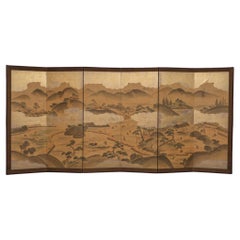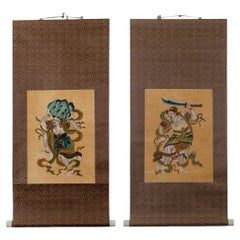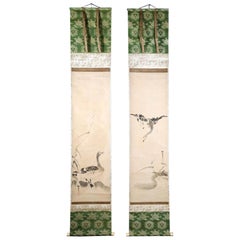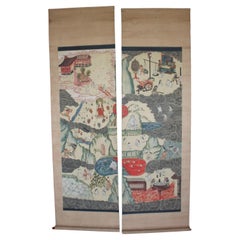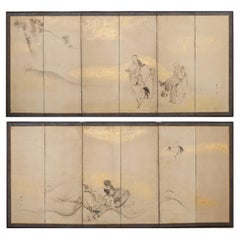Items Similar to Pair of Japanese kakejiku 掛け軸 (hanging scrolls) depicting Niô guardians 仁王
Want more images or videos?
Request additional images or videos from the seller
1 of 21
Pair of Japanese kakejiku 掛け軸 (hanging scrolls) depicting Niô guardians 仁王
$16,782.51per set
£12,467.05per set
€14,000per set
CA$23,304.44per set
A$25,430.55per set
CHF 13,338.75per set
MX$308,862.50per set
NOK 166,608.34per set
SEK 157,453.21per set
DKK 106,580.53per set
About the Item
Pair of impressive, antique kakejiku (hanging scrolls) showcasing the awe-inspiring Niô guardians, also referred to as heavenly kings.
Each painting captures one of the two guardians: Agyô with an open mouth and Ungyô with a closed mouth. The intricate details of their muscular bodies, flowing robes, and dynamic garlands are skilfully depicted. Adorned with necklaces, bracelets, and armlets, they exude a powerful presence. One of the guardians holds a Buddhist tuning fork, while the other wields a thunderbolt sceptre. Their fierce and almost grotesque expressions are characterized by large bulging eyes and furrowed brows, adding to their formidable aura.
These expressive and polychrome paintings are finely rendered on silk using ink and watercolours. They are presented as hanging scrolls with silk brocade frames. The jikusaki (rod ends) are made of red lacquered wood with an engraved scrolling foliage design.
Dimensions, each:
Image: Height 50.19 inch/127.5 cm, Width 29.76 inch/75.6 cm.
Entire scroll:
Image: Height 75.59 inch/192 cm, Width 36.02 inch/91.5 cm.
With an old black-lacquered wood tomobako (storage box).
Niô, also known as Kongôrikishi, are formidable and muscular guardians commonly found at the entrances of Buddhist temples in East Asian Buddhism. These guardians are depicted as intimidating statues resembling powerful wrestler-like beings. They are considered manifestations of the dharmapala Vajrapani, the oldest and most potent deity in the Mahayana Buddhist pantheon. According to Japanese tradition, the Niô accompanied Gautama Buddha to ensure his protection. While Buddhism is generally characterized by non-violence, the stories of dharmapalas like the Niô justified the use of force to safeguard cherished beliefs and values from evil. The Niô are also associated with Mahasthamaprapta, the bodhisattva of power in Pure Land Buddhism, and Vajrasattva in Tibetan Buddhism. As a pair of figures, they often stand under a separate temple entrance gate known as Niomon in Japan. The right statue, known as Misshaku Kongô or Agyô, has an open mouth, while the left statue, Naraen Kongô or Ungyô, has a closed mouth. Symbolically, they represent the concept of "everything" akin to the notion of Alpha and Omega in Christianity.
When shipped we will add a certificate of authenticity.
Price including insured shipping.
- Dimensions:Height: 75.6 in (192 cm)Width: 36.03 in (91.5 cm)Depth: 0.04 in (1 mm)
- Sold As:Set of 2
- Materials and Techniques:
- Place of Origin:
- Period:
- Date of Manufacture:Around 1700, Edo period
- Condition:Repaired. Wear consistent with age and use. Considering their age, they are in overall good condition, with some signs of wear, soiling, creasing, and a few minuscule losses. The mountings also exhibit some wear and small tears, and small restoration. Please look at the photos for a condition.
- Seller Location:Amsterdam, NL
- Reference Number:Seller: 813831stDibs: LU7165234248942
About the Seller
4.8
Vetted Professional Seller
Every seller passes strict standards for authenticity and reliability
Established in 1996
1stDibs seller since 2022
22 sales on 1stDibs
Typical response time: 1 to 2 days
- ShippingRetrieving quote...Shipping from: Amsterdam, Netherlands
- Return Policy
Authenticity Guarantee
In the unlikely event there’s an issue with an item’s authenticity, contact us within 1 year for a full refund. DetailsMoney-Back Guarantee
If your item is not as described, is damaged in transit, or does not arrive, contact us within 7 days for a full refund. Details24-Hour Cancellation
You have a 24-hour grace period in which to reconsider your purchase, with no questions asked.Vetted Professional Sellers
Our world-class sellers must adhere to strict standards for service and quality, maintaining the integrity of our listings.Price-Match Guarantee
If you find that a seller listed the same item for a lower price elsewhere, we’ll match it.Trusted Global Delivery
Our best-in-class carrier network provides specialized shipping options worldwide, including custom delivery.More From This Seller
View AllPair of Japanese hinagata byôbu 雛形屏風 (small folding screens) with flower carts
Located in Amsterdam, NL
An amazing pair of six-panel hinagata byôbu (doll festival folding screens) with a continuous painting on gold leaf showcasing flower carts (hana’guruma) at the edge of a winding river.
Both laden with a large bamboo basket...
Category
Antique Early 19th Century Japanese Paintings and Screens
Materials
Gold Leaf
$4,315 / set
Free Shipping
Large Japanese 6-panel byôbu 屏風 (folding screen) with Edo genre painting
Located in Amsterdam, NL
An elaborate, large six-panel byôbu (folding screen) featuring a detailed genre painting on gold leaf, capturing the vibrancy of festive scenes from the Edo period.
Central to the p...
Category
Antique Early 19th Century Japanese Paintings and Screens
Materials
Metal, Gold Leaf
Mid-size 6-panel byôbu 屏風 with a scene from The Tale of Genji
Located in Amsterdam, NL
A refined medium-sized six-panel byôbu (folding screen) showcasing a classical autumn court scene from chapter 7 of The Tale of Genji (Genji Monogatari), titled Momiji no Ga (The Aut...
Category
Antique 17th Century Japanese Paintings and Screens
Materials
Metal, Gold Leaf
Large Japanese 6-panel byôbu 屏風 (folding screen) with genre painting
Located in Amsterdam, NL
Fascinating large six-panel byôbu (folding screen) with a detailed genre painting on goldish silver leaf with different scenes of people at work in a rural mountain village during th...
Category
Early 20th Century Japanese Paintings and Screens
Materials
Silver Leaf
Rare set of 2 Japanese suits-of-armour, complete with 2 matching folding screens
Located in Amsterdam, NL
Important unique set of two suits-of-armour (yoroi), complete with two high six-panel screens, that belong together as is indicated by the used family crests (mon). Two crests are used, both belonging to the Nakagawa family of Oka Castle, Ôita prefecture on Kyûshû.
They are:
– the Nakagawa-kurusu, a circle depicting a Celtic-like cross through a ring.
The cross was originally a Christian symbol but after the ban on Christianity in Japan the use of a hidden cross in family crests could continue.
– the Nakagawa-kashiwa, two leaves of the Japanese Emperor Oak turned to each other (dakikashiwa mon).
The remarkable aspect of this ensemble is the presence of matching crests on both the yoroi and the accompanying folding screens. The kurusu and kashiwa crests adorning the yoroi are elegantly replicated on the screens, providing compelling evidence that these pieces form a harmonious and unified set. This exceptional cohesion between the armour and screens further enhances their artistic and historical value.
After the warlord Toyotomi Hideyoshi (1537-1598) had interfered in the battle between the Lord of Bungo Province Ôtomo Yoshi-mune (1558-1605) and the Shimazu of Hyûga Province, he split the Bungo Province in a number of small fiefs and transferred in 1594 Nakagawa Hideshige (1570-1612) from Miki Castle
in the Harima Fief to Oka Castle in Kyûshû.
The Nakagawa family stayed in possession of Oka Castle till the abolishment of the military use of castles in 1873. In 1884 the Nakagawa family received the title of Count (a title in use till the abolishment of aristocracy in 1947).
After the Nakagawa’s left, the castle and the building soon dilapidated and is now known as Oka Castle Ruins. The castle is located in Taketa Village part of Taketa Town in Ôita Province on Kyûshû.
> Set of two tall byôbu (folding screens),
painted with large red jinmaku (camp enclosure curtain) on a gold leaf ground. The curtains show both crests of the Nakagawa family: one screen depicts two Nakagawa-kurusu crests next to a Nakagawa-kashi crest in the middle, and the other shows the symbols the other way round.
Dimensions:
Total width 148.66 in/377.6 cm (2 x 25.35 in/64.4 cm, 4 x 24.48 in/62.2 cm); Height 72.63 in/184.5 cm.
Period: Japan – Late Edo period (First half 19th century), and maybe even older.
> Yoroi with Nakagawa-kashiwa crest:
A Japanese black lacquered suit-of-armour (yoroi) completely laced with orange cords (kuro’urushinuri hi’ito odoshi nimai’dô’maru).
A thirty-two plate suji’bachi kabuto (helmet with raised ridges) with in front a maedate (fore crest) -with traces of gilding- in the shape of flames, resembling a mythical flaming bird flying down. The fukikaeshi (face guards) and the mabizashi (visor) have the Nakagawa-kashiwa crest in gold maki-e lacquer.
Five curved ‘itazane’-plate neck guards (shikoro) laced with orange cords.
Together with an ‘angry man...
Category
Antique 18th Century Japanese Antiquities
Materials
Gold Leaf, Iron, Metal
Large Japanese 6-panel byôbu 屏風 (folding screen) with chrysanthemum garden
Located in Amsterdam, NL
A very colourful and captivating large six-panel byôbu (folding screen) with a refined continuous painting of a luscious flower garden filled with many different types of chrysanthemums (kiku), next to a winding river.
This multi-coloured painting is set on a shiny gold-leaf background, and the chrysanthemum flowers are painted by using shell paste (gofun) in low relief.
Several clutches with a great variety of chrysanthemum flowers are in full bloom and they each show their unique form and colour. Varying from white, red, yellow and pink. The flowers bloom all around and on different kinds of bamboo fences and trellises.
In Japan chrysanthemums are believed to represent happiness, love, longevity and joy.
The panels are surrounded by two silk borders, a thin black one, and a wide brown one. The screen is protected by a black and red negoro’nuri...
Category
Antique Late 19th Century Japanese Paintings and Screens
Materials
Gold Leaf
You May Also Like
A Pair of Buddhist Guardian Scrolls
Located in Savannah, GA
A pair of Buddhist guardian scrolls, 20th century.
scroll: 15 ¾ inches wide by 33 inches tall
painting: 10 ¾ inches wide by 15 inches tall
Category
20th Century Unknown Decorative Art
Materials
Paper
$900 / set
Pair of Japanese Ink Hanging Scrolls Kano Tanyu
By Kano Tan'yu 1
Located in Atlanta, GA
A fine matching pair of hanging scrolls ink on paper mounted in green brocade borders circa Edo period (17-18th century). The Kano school painting depicts wild geese in the reeds by the margin of water, a popular subject borrowed from the Chinese tradition. Both painting were signed as Tanyu with a red seal of Morinobu, his birth name. The storage box is also present and was inscribed with the title Painting of Geese and Reeds and Kano Tanyu...
Category
Antique Late 17th Century Japanese Japonisme Paintings and Screens
Materials
Wood, Paper
$6,000 / set
Japanese Antiques Hell paintings, pair of hanging scrolls Kakejiku
Located in Niiza, JP
Paper scroll, scroll head: wood
paint size: 450 (W) x 1200 (H) [mm]
Over all: 510 (W) x 1700 (H) [mm]
Comes with double box. box size: 150(W)× 100(H)× 620(D) [mm] 2kg
Estimate pack...
Category
Antique 19th Century Japanese Paintings and Screens
Materials
Paint
Pair of 18th Century Japanese Edo Screens of Chinese Immortals
Located in Rio Vista, CA
Mesmerizing pair of late 18th/early 19th century Japanese Edo period byobu screens by Shibata Gito (Japanese 1780-1819). The paintings depict Chinese immortals in a dreamy landscape....
Category
Antique 18th Century Japanese Edo Paintings and Screens
Materials
Silk, Wood, Paper
Pair of Scrolls: Chinese Court Figures (Taoist Ceremonial Painting)
Located in Hudson, NY
Mineral pigments on paper. Mounted panels. Top center reads: Fuku (Wealth)
Category
Antique Early 19th Century Chinese Paintings and Screens
Materials
Paper
Antique Japanese 17th c Edo Scroll Kano Yosanobu Buddhist Painting
Located in Amsterdam, Noord Holland
Eishin Kano's Ebisu/Great Country Map, double-width/comes with an old box.
The auspicious statues of Ebisu and Daikoku are standing in a double-width hanging scroll with a smiling fa...
Category
Antique 18th Century Edo Paintings
Materials
Silk
$3,450 Sale Price
20% Off
More Ways To Browse
Japanese Lacquer Panels
Chinese Carved Screen
Kano School
Byobu Screens
Asian Black Screens
Japanese Folding Screen Screen
Japanese Silk Brocade
Asian Cranes
Chinese Silk Paintings
Mid Century Chinese Screen
The Imperial Palace Of China
Asian Art On Paper
Japanese Painting Silk Gold
Japanese Flower Painting
Japanese Showa Screen
20th Century Japanese Folding Screen
Japanese Folding Screen Art
19th Century Chinese Painting On Silk
